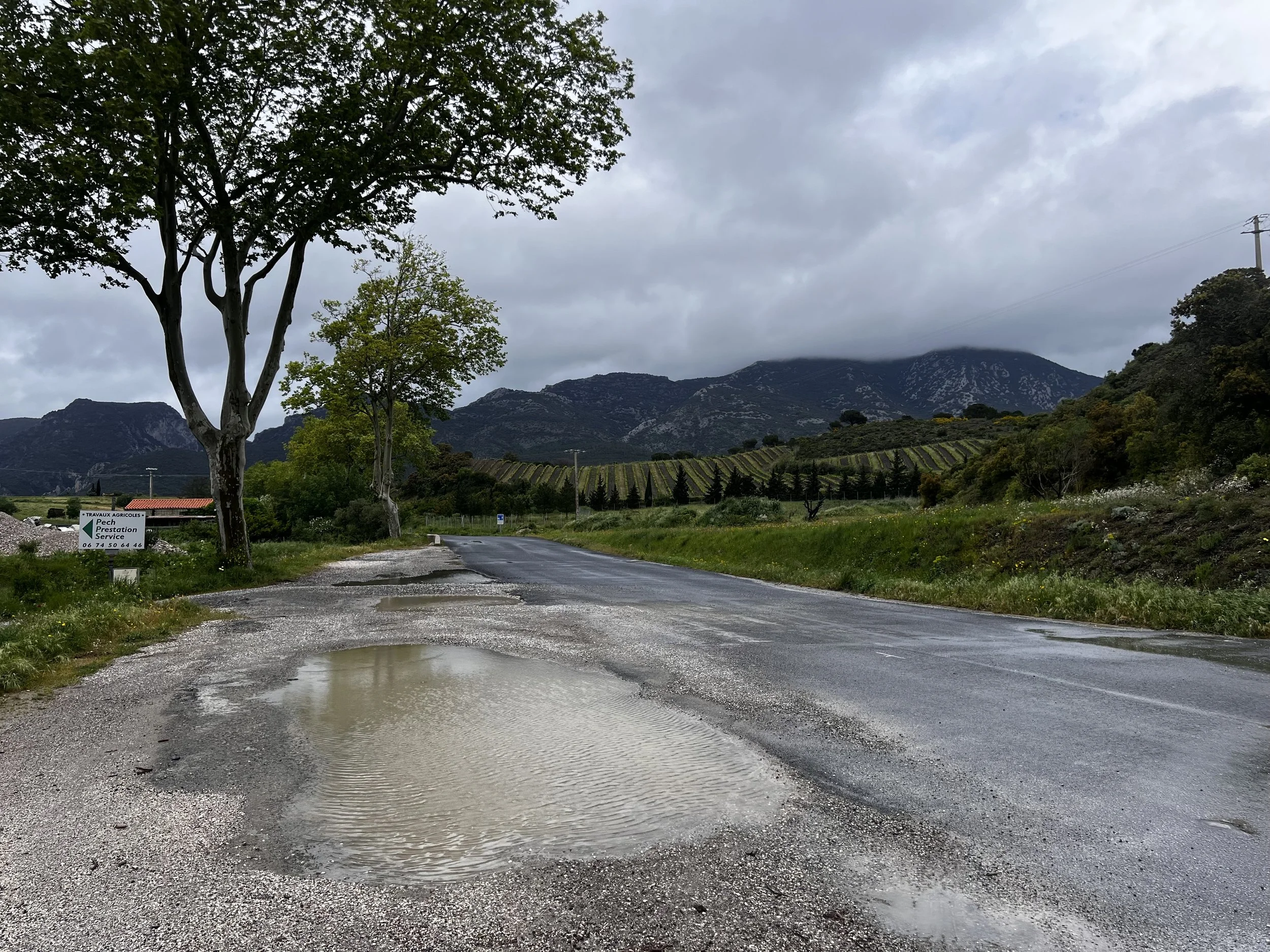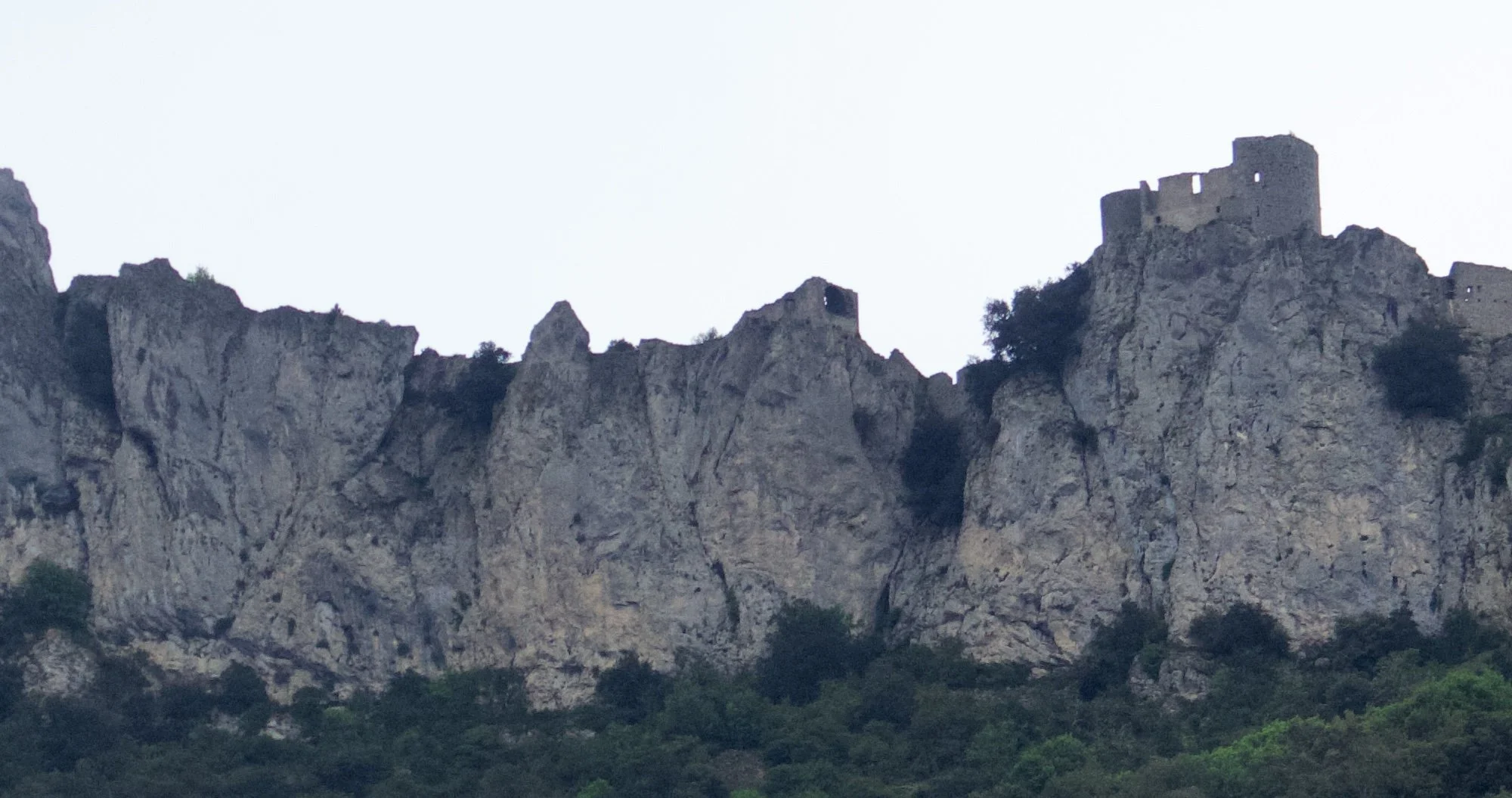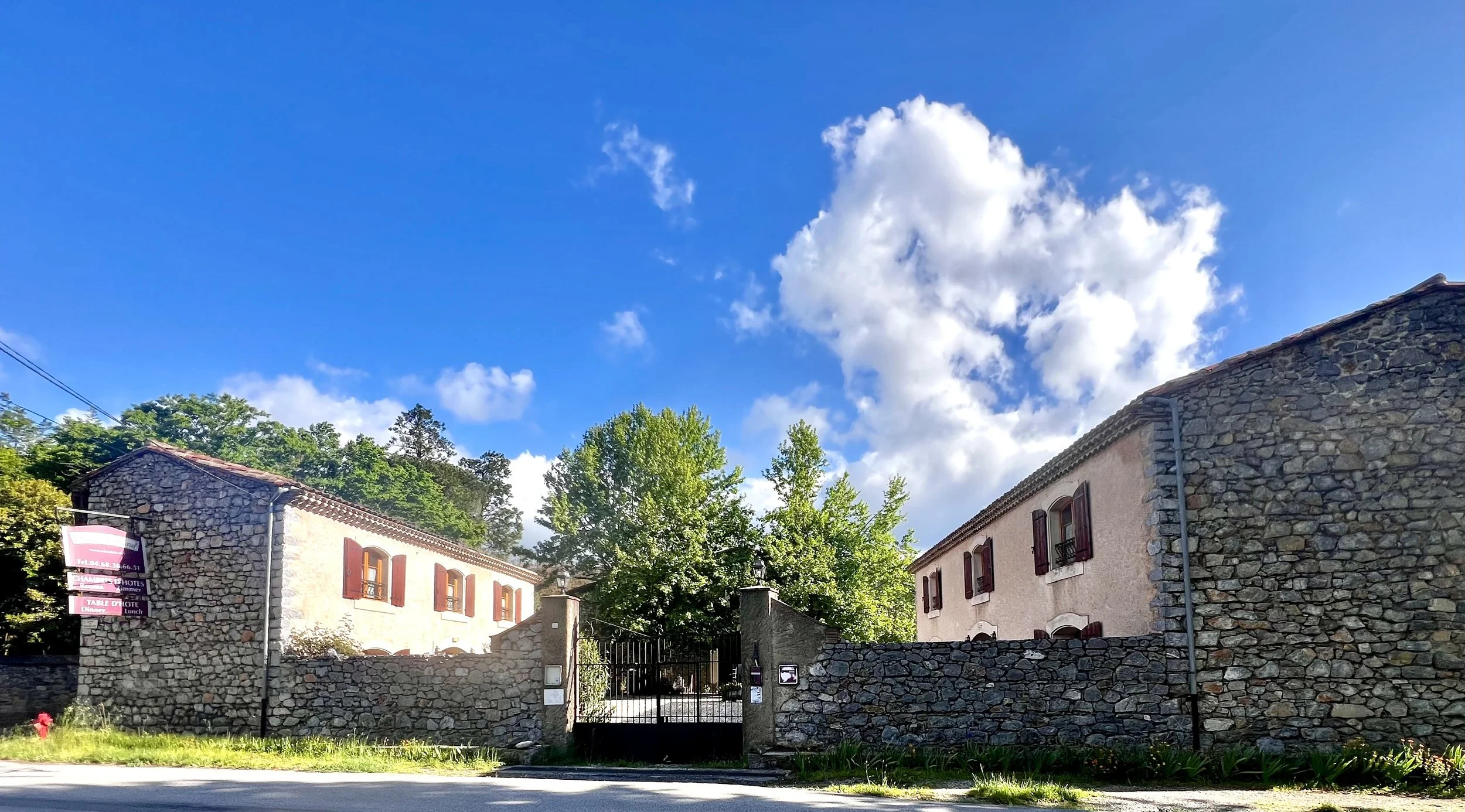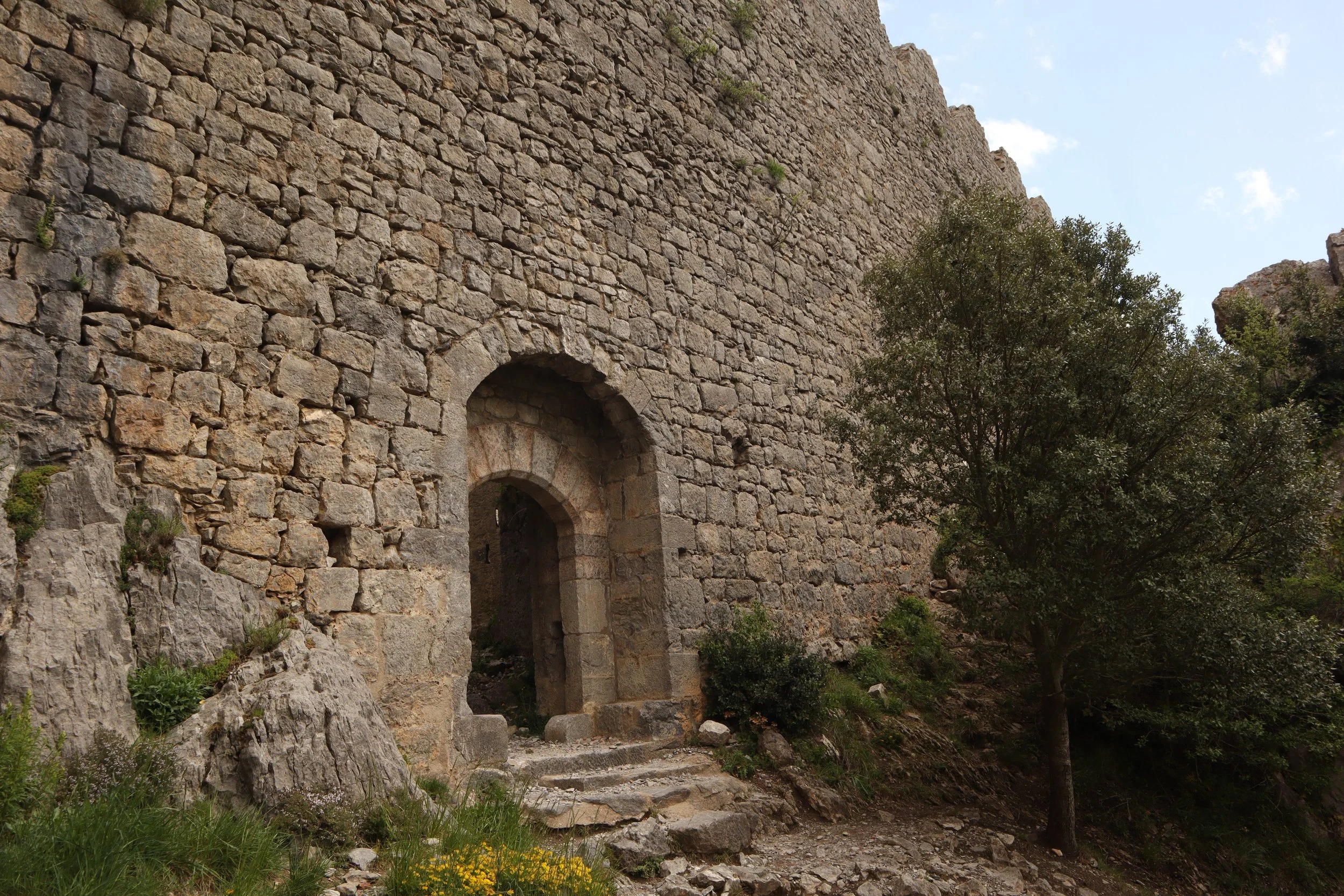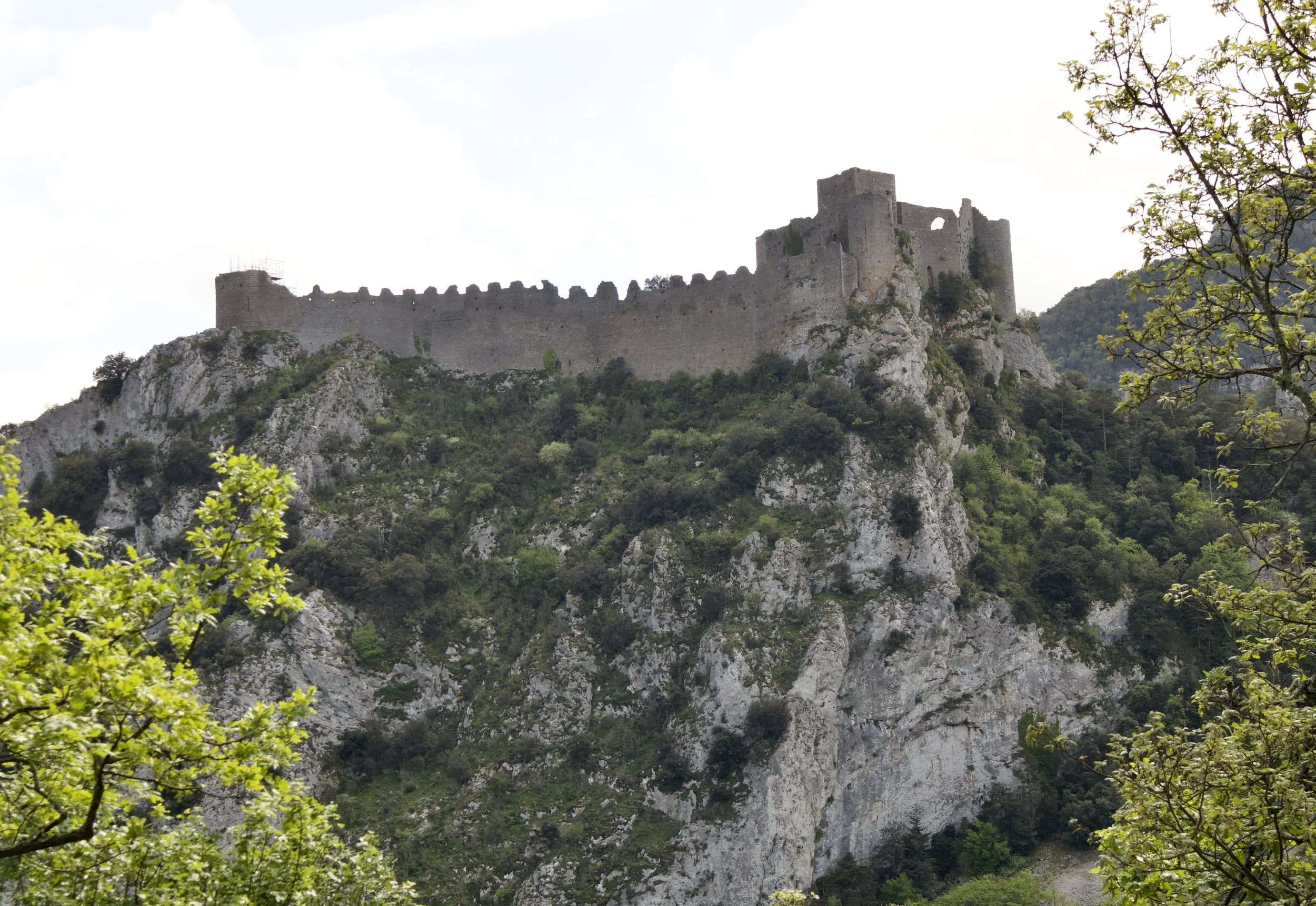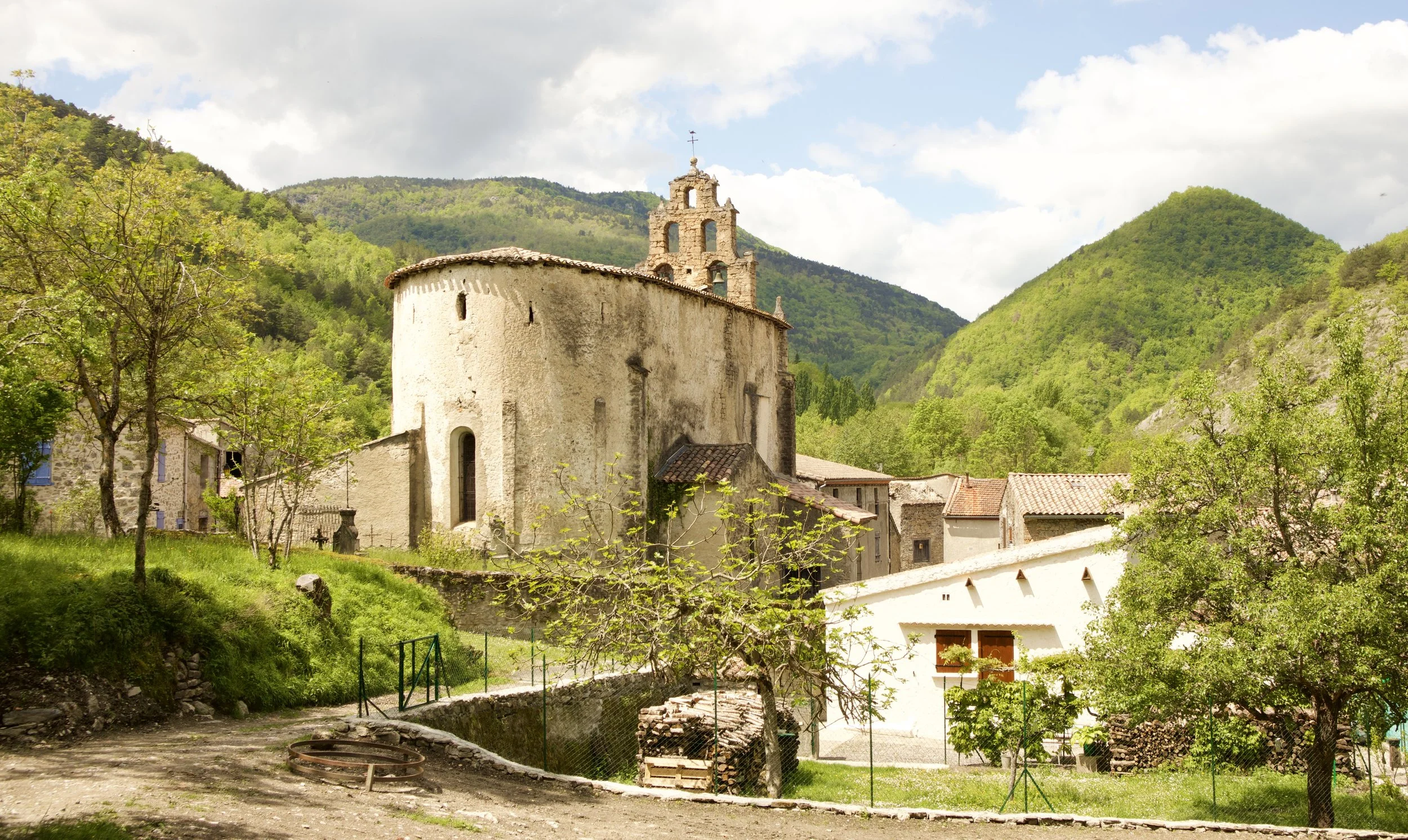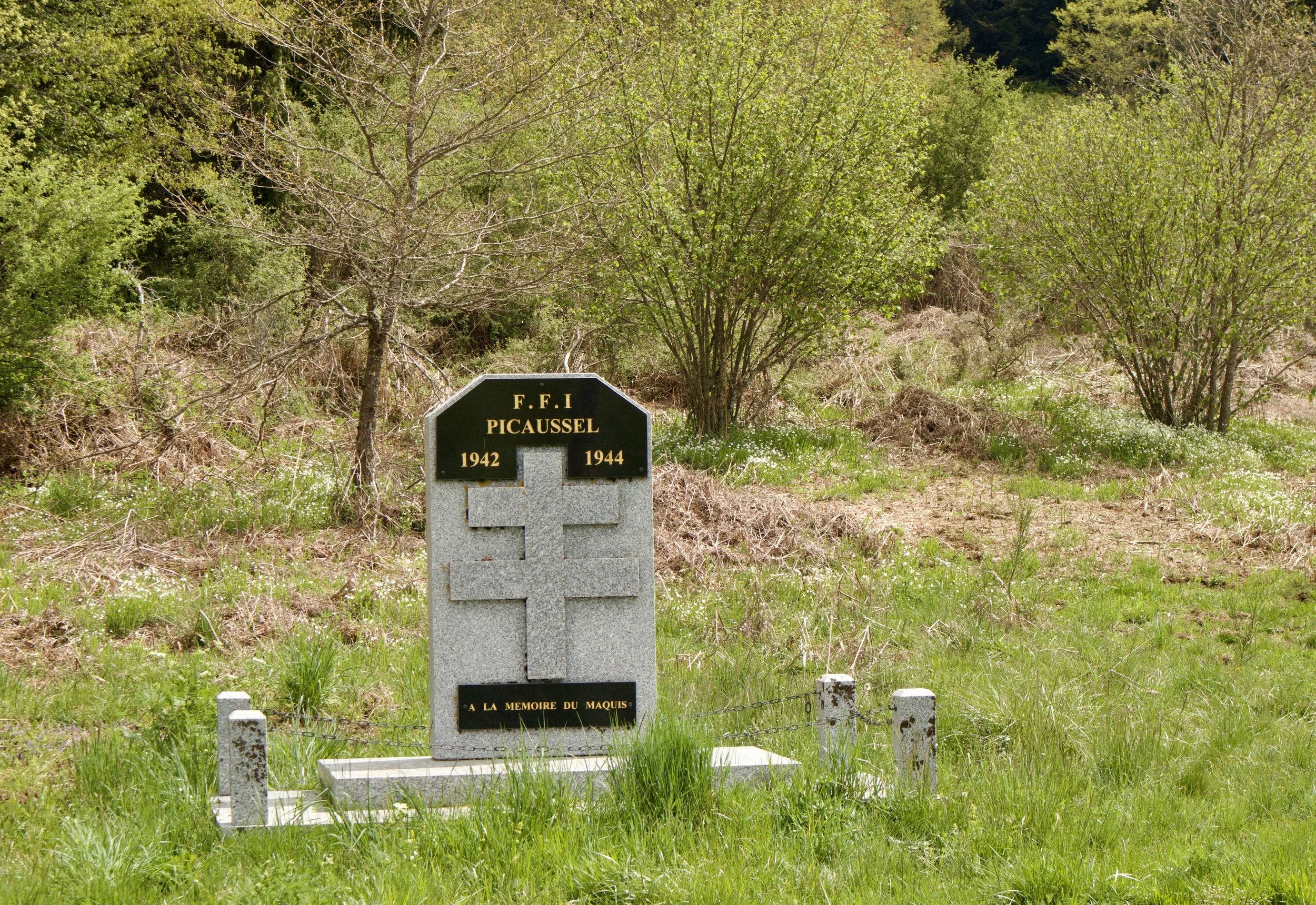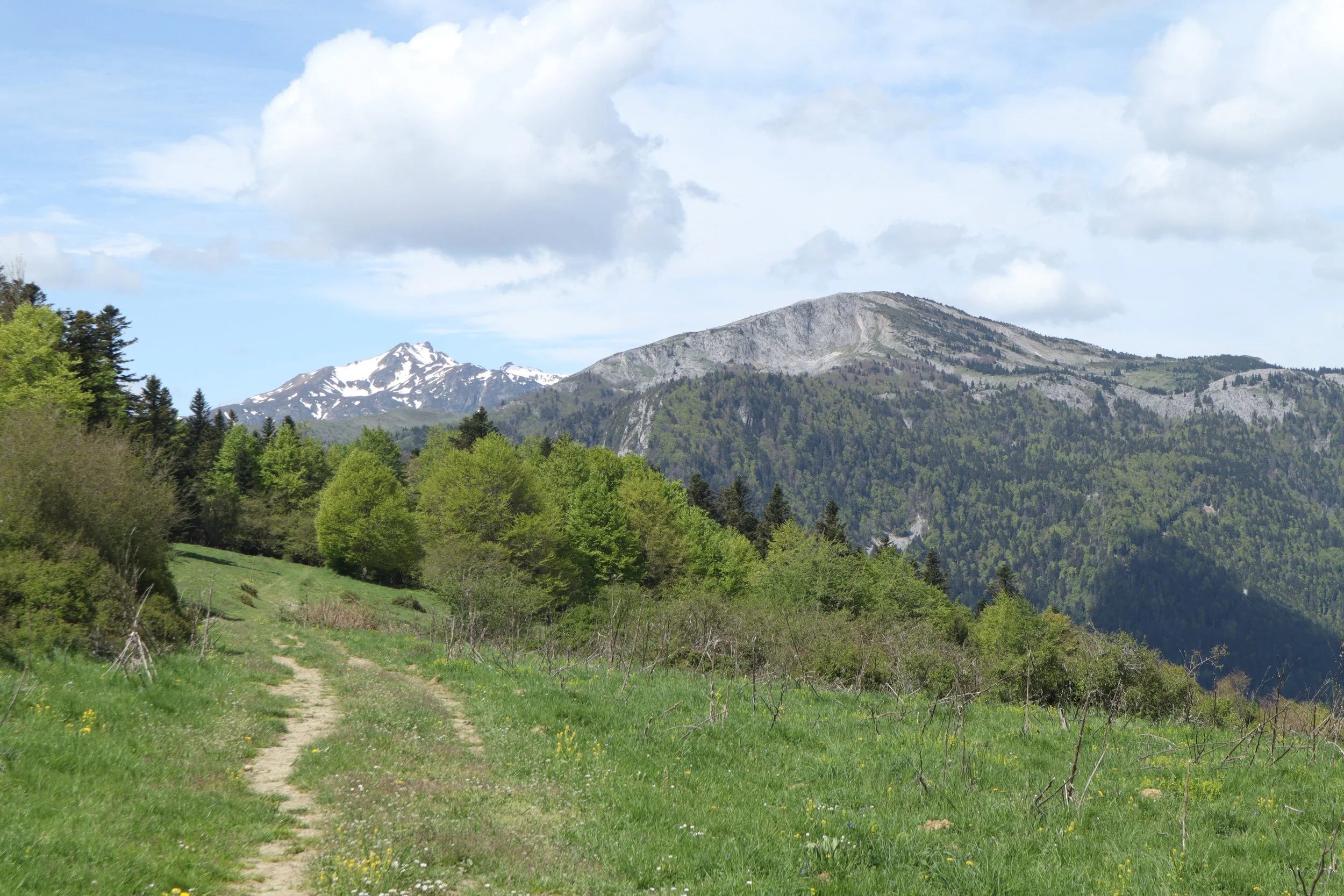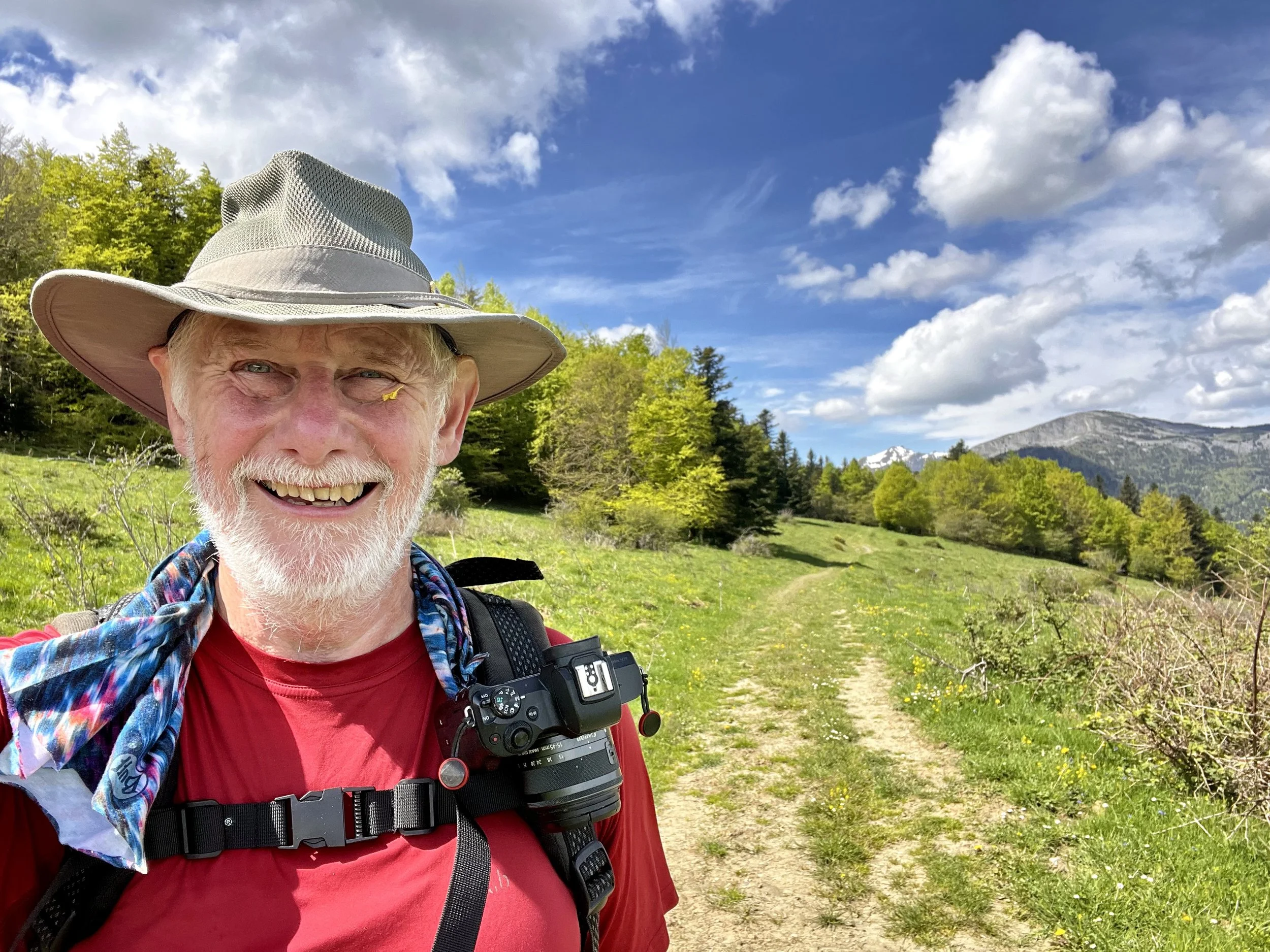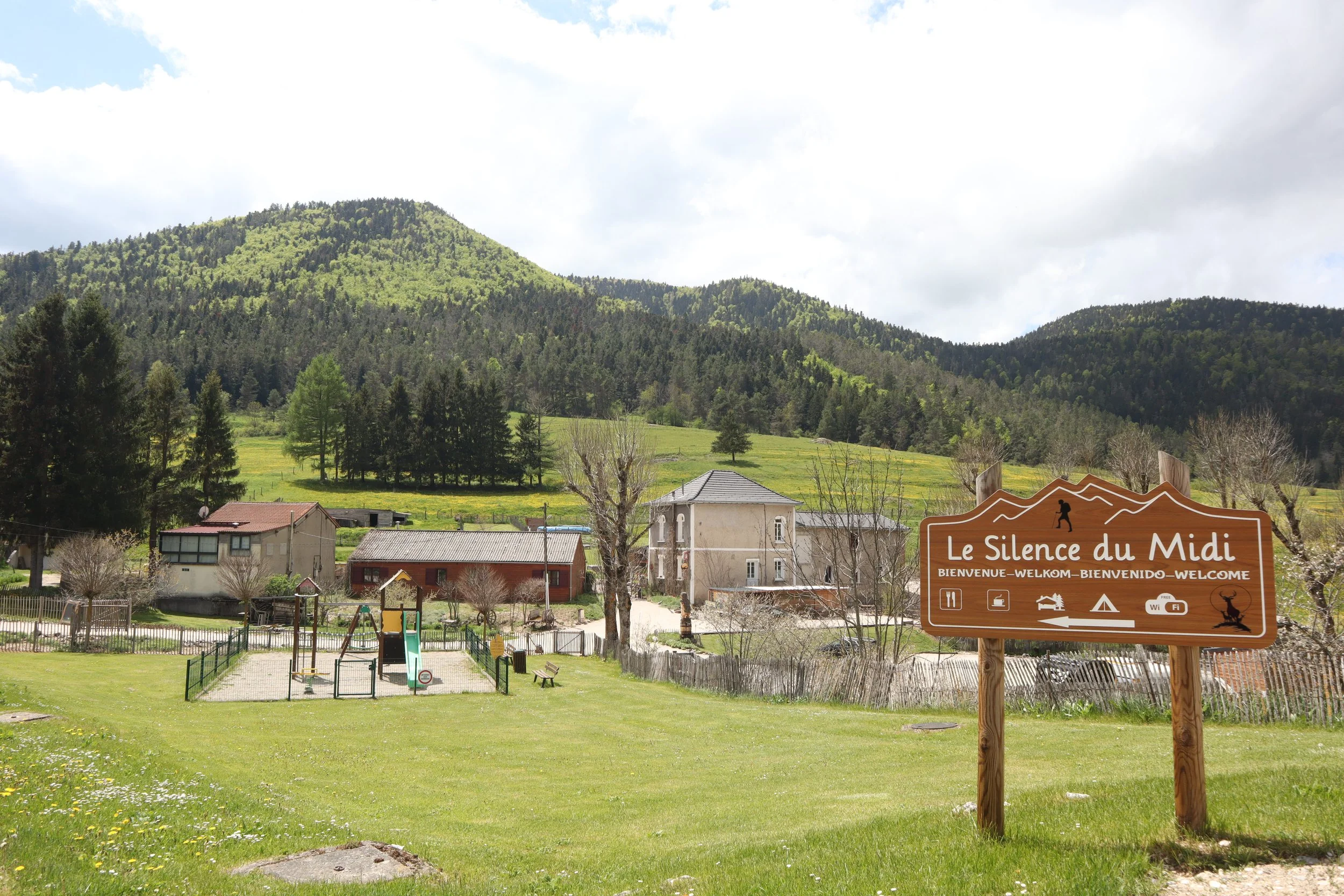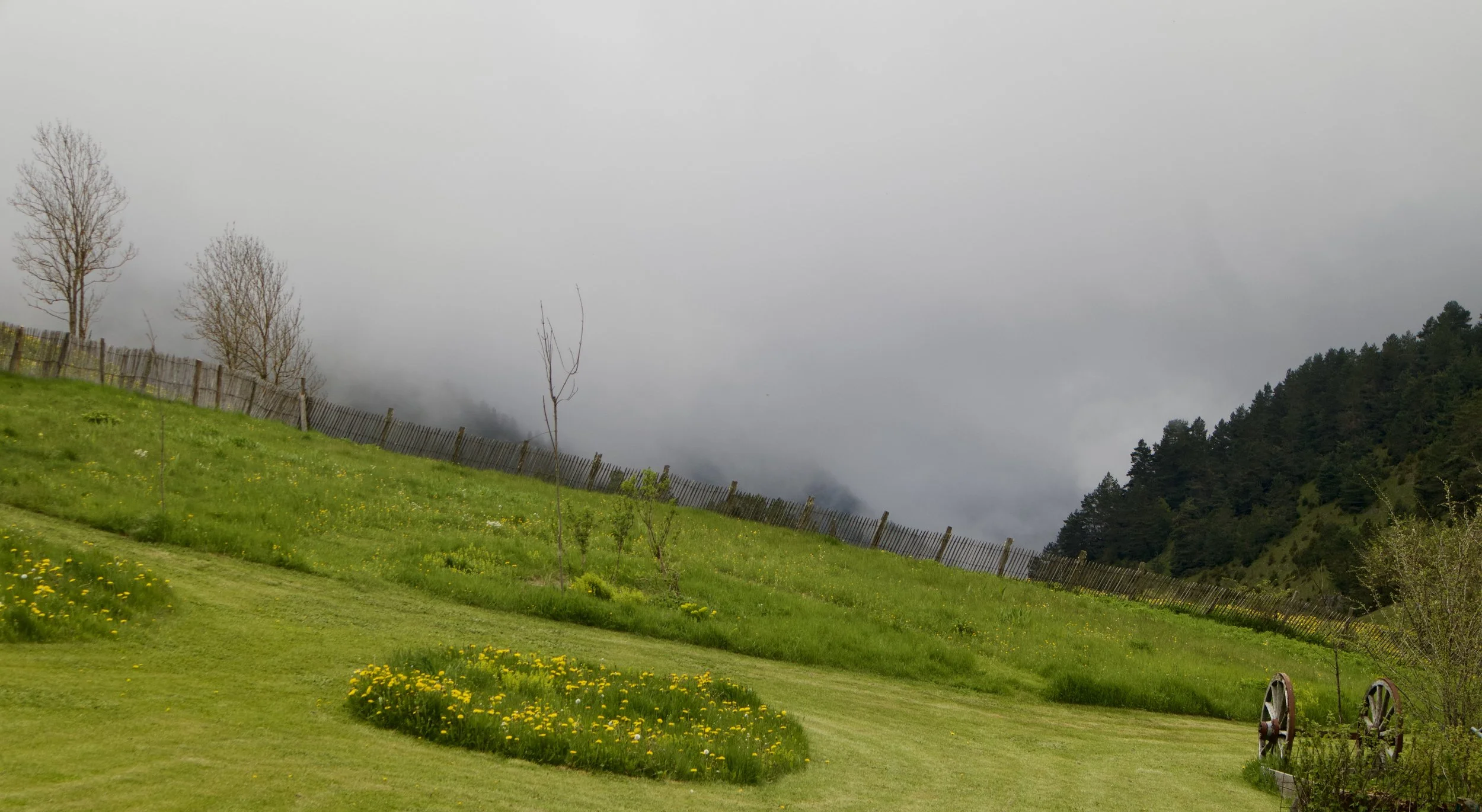The heart of the Sentier Cathar
The Meteo was spot on and I spent Sunday 4th of May in my caravan listening to the thunder roll around the hills and the rain hammer on the caravan’s canvas roof. I was using a rest day earlier than planned but with the weather the way it was I was in the best place, the alternatives, walking though the storm or sitting it out in the tent would have been miserable.
The day was taken up with resting and washing clothes. On a backpacking trip like this the rule is to carry as little as possible so washing tee shirts etc. is a regular activity.
The storm blew itself out overnight and when I left the campsite on Monday things had improved to drizzle with occasional squally showers, not great but it could’ve been worse.
A soggy start to Monday.
I had been hoping to visit another castle, Peyrepertuse, but with the weather only allowing occasional glimpses of it perched high on another mountain crest I decided against it. I also declined to climb the Pech de Auroux, a very big mountain just after lunch; mountains and thunderstorms are a poor mix and there were still enough random rumbles to incline me to discretion over heroism (I must be getting old).
Near the foot of the Pech de Aroux an alternative path took me down to St Paul de Fenouillet, this turned out to be such a time saver I was able to push on to the next village, Caudies de Fenouilledes.
Peyrepertuse Castle caught between showers.
It was quite late when I arrived, the weather was still pretty iffy and with another three kilometers to the campsite so I elected to stay in a gite, or rather a very up market guest house. This Chambres d’hote was a converted winery built about 1880 but now fully modernized and made quite luxurious.
The food was also pretty luxurious and apart from the prawns in the salad everything came from with 5km of the kitchen. I know this because Madame gave us the provenance (I’ve never used that word before) of each dish as she served it.
Le Relais de Laval- very up market accommodation.
Serving a most spectacular and delicious salad.
No early start, breakfast was a long luxurious affair but eventually I got going about 9:30.
This was going to be about 15 miles and included a visit to Puilaurens castle but before that highlight was the Saint Jaume Gorge. This is a very narrow, deep and beautiful chasm which the route followed upwards on paths hacked from the cliff sides. I have no idea why these paths were created but they provided a pleasant hour or so’s entertainment.
The bold adventurer with the St Jaume Gorge behind.
In the gorge, the path was quite interesting.
Out of the gorge the route continued upwards on forest tracks that, just for once, were pleasantly graded and not washed out.
Lunchtime arrived and with it Puilaurens castle, too good not to visit and only an extra 500 feet of climbing.
The castle visit took about an hour, after which I passed the afternoon descending to a campsite near Axat on more easy woodland tracks
The main entrance to Puilaurents castle.
The courtyard.
Some battlements.
Puilaurents from across the valley.
I had an early start from the Axat campsite as it promised to be a quite arduous day but stopped in the village to buy provisions and breakfast. Fortified but a very rich croque-monsieur (cold toasted ham and cheese sandwich), it was onwards and upwards.
A long way upwards, just over 3250 feet of ascent in eight miles, a bit of a slog, especially the last 1000 feet or so.
Eventually the fun was over and I reached the hamlet of Quirbajou perched high in the forest clad hillside.
A very old church at the hamlet of Camilla on the path up to Quirbajou, every small village and hamlet has an old church, the population density must have been higher in the past to support them all.
There was nowhere flat enough to pitch a tent so I’d booked into the hamlet’s small gite, a classic collection of old buildings sort of knocked together and sort of modernised.
Just for once I wasn’t the only person in the place, I was joined by a small party of horse trekkers, they’re like pony trekkers but ride big horses and have a mini-bus to transport all their luggage. There were five in the group, a French guide, three ladies from Britain and a chap from Sweden possibly called Karl
The ladies were all long term friends who talked about horses, to the exclusion of almost all else; I did try and open several topics, but to no avail, they also had OPINIONS, mostly about horses.
Karl hardly said a word, he didn’t speak French and his English wasn’t good. He also didn’t eat much; he was a vegetarian that didn’t like courgettes or buckwheat, this was a problem as the main course was a local sausage, buckwheat and courgette stew, and to cap it off he was teetotal!
I did wonder why he chose what was probably a very expensive holiday to an area that is famous for its robust peasant food and red wine. He certainly didn’t seem to be having an enjoyable time.
Apparently horse riding is particularly tiring and everyone went to be at 8:30, leaving me and Florence, the owner of the gite, to finish the wine and chat.
The gite at Quirbajou.
Florence, a lovely lady.
Breakfast was excellent, although horses again dominated the conversation so it was with some relief that I left at about 8:30.
Another steep 1200 feet of ascent was followed by a very pleasant and scenically inspiring stroll on good forest tracks down to the village of Puivert and another castle.
Puivert castle is a bit different from the castles I’d already visited, built on a low hill rather than a high mountain outcrop it had been a seat of administrative as well as military power and had been an important cultural centre before the Cathar Crusade (Elinor of Aquitaine, wife of Henry II, mother of Richard the Lionheart and bad King John, hosted a troubadour competition here).
It was therefore built to a different plan, with a long curtain wall enclosing a large court yard and a relatively luxurious main keep where the important people stayed.
Puivert castle.
Vaulted roof inside the main keep, quite luxurious for the 12th century.
After the castle, it was a quick stroll down to the village where I had a couple of shocks; first the campsite was closed for another week and there was a huge fete going on, music, food, games and a vast car boot sale, all in honour of VE Day, I knew it was the 80th anniversary but didn’t think much about it.
However the locals did think a lot about it; this area was a very active centre for the Maquis, the French resistance, in WW2, and the local fighters had been so effective that the Germans had waged a war of reprisals against the locals, including raising one village, L’Escale, to the ground in 1944 (the German government had it rebuilt in the 1950’s).
Consequently every where was full but I eventually found a small hotel with a vacancy, this came as a huge relief as a wild camp in the corner of a field was looking like a real possibility.
The hotel turned out to be owned by an Englishman, Martin who’d moved here nearly 30 years ago. The hotel didn’t do an evening meal but there was a bar a few yards down the road that had an excellent menu.
The bar was owned by an English couple, and half the customers were British, it seemed that Puivert was the centre of a thriving ex-pat community; this was confirmed the next morning by an English lady, complete with Barbour jacket out exercising he golden retriever.
Despite the good food and a couple of nice beers I went to bed with some trepidation, the Meteo forecast was terrible, thunderstorms and heavy rain for the next five days. It looked so bad that I’d sat in the bar and worked out an alternative itinerary for the rest of my time in France.
Screenshot of the Meteo forecast, not looking good.
The River Blau flowing through Puivert.
One of many memorials to the Maquis resistance fighters on the way to Puivert.
Fortunately the forecast had improved by the morning and with hope in my heart I set off again. This easy day, only 11 miles and 1700 feet of climbing, initially the path out of Puivert took me though fields and farms until it reached the forested hills and then it was upwards.
The forest tracks on were much better than earlier ones, better graded and easier on the feet. The forests had also changed, the previous scrub woodland, with its stunted trees have been replaced by proper forests of pine, oak and beech, but primarily pine. Big trees need a lot of water and these mountains get a fair amount of rain and snow in the winter and as I was now very aware in the spring as well.
Excellent forest tracks, the only issue is the trees reduce the views.
The campsite at Roquefeuil was excellent, and the village had a very pleasant bar, so after a couple of beers I settled into my tent.
However, the night was much colder than I’d expected, a combination of clear skies (very impressive starts)and relatively high altitude (the campsite was a little over 3000’) dropped temperatures down to nearly freezing. A bit too cool for the gear I’d brought, so I woke up chilled in a tent soaked with dew and condensation. An early and vigorous start ensued in an effort to get warm.
It was also in a race against the weather, while the forecast was much better than it had been, the meteo was predicting storms for Comus, my destination, from late afternoon.
I was therefore determined to get up high and enjoy the scenery before the bad weather arrived and made life unpleasant.
The initial climb was through more forests until I arrived in the rolling pastures of the Plateau de Languerail at well over 4200’ the plateau was a joy to stroll over, the path was mostly easy on the feet and legs and the views were a delight to the eyes and soul.
The Plateau de Languerail, a dramatic high plateau with inspiring views all around.
In Pyrenean term 4,200’ isn’t that high, the main peaks reach over 11,000’ but it’s still pretty lofty and there were inspiring views of big snow capped peaks not far away.
Descending to the hamlet of Comus was quick and easy along more forests until tracks which not only provided easy walking but glimpses of the huge Frau Gorge and distant Montsegur castle, both on Monday’s itinerary.
Looking around the Plateau de Languerail.
The bold adventurer really enjoying the Plateau de Languerail.
I’d booked a room and board at the gite for two nights, the forecast was still for thunderstorms and I wanted a rest after walking for six days (70 miles and 18,000 of ascent).
The rest day was a huge success, I dried my dew drenched tent, then washed and dried all my tee shirts and other laundry.
However by 15:00 the forecast storm arrived, with the clouds dropping several thousand feet and the temperature 5 or 6 degrees.
